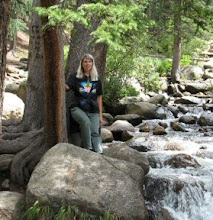
"Home," in the immediate personal sense, is just out of the picture on the left edge, enabling an excellent view north up the valley into the dramatic sculptures of red sandstone. What intrigues me today is that I fell in love with this view, this area, long before I ever saw it. Growing up in New York State, I couldn't even imagine such landscapes. The photo below, in a college textbook many years ago, introduced me to the concept of a hogback, the striking feature that dominates this photo and now defines my home range.
This geological paradise is hemmed in by the 1.7-billion-year-old rocks of Mt. Morrison on the left and the Dakota Hogback, which defines the eastern edge of the foothills and almost seems to confine the denser forms of human civilization to the plains beyond it. A virtual border we cross regularly, it marks a change in perspective from urban to mountain, from human-dominated landscapes to those where Nature, and especially geology, are factors that can't be entirely forgotten.
These photos, taken more than 50 years apart, also express change. In the earlier image, we see almost nothing artificial. A stretch of the Turkey Creek road on the west (left), a quarry lake on the right, but little else of human creation is visible, despite more than 70 years of "civilized" occupation of this landscape. Another half-century brings a few differences we can see at the scale of these photos. Houses and trees now obscure the road to Turkey Creek. The Dakota Hogback remains, but its base is scarred by a local speedway and a new road traverses it. But the delicate fin of limestone that lay east of it has been obliterated by a superhighway. Still, this landscape is largely protected compared with others in the Front Range. Much of the area of this photo is parkland and open space, preserved for its beauty and for use for recreation.
My very first geology professor taught us that geology is everything. He got our attention; to him even the Civil War was a matter of geology. The Industrial Revolution? Fueled by geology. The unique characters of New York, Pittsburgh, Chicago, San Francisco, New Orleans are shaped by their geology. Civilizations rising or falling, wars won or lost, all were geology, if you looked deeply enough. Geology is, according to ecologist Paul Sears, "the Great Eye-Opener" we need to understand the landscapes we live in and how they shape us. In short, Geology Rocks!


1 comment:
IN my next life, I'm coming back as a climatologist or geologist. I've not been out west much--an hour in the badlands and an hour in the big horns is about it. But I do appreciate the role of geology here in the southern Appalachians--for its role in early migration up the Great Valley (a product of erosive limestone between resistant sandstone fold-fault mts) and for our unique water situation here in Floyd County Virginia and so on.
Post a Comment